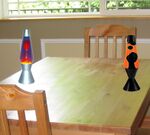War of the Lava Lamps
| War of the Lava Lamps | |
|---|---|
 A still from the film | |
| Directed by | Sam Spielberg |
| Produced by | Kitty Spielberg |
| Written by | Sam Spielberg |
| Release date(s) | July 7, 1997 (United States) |
| Running time | Too long |
| Country | United States |
War of the Lava Lamps is a 1997 American film written and directed by Sam Spielberg, the founder of Kitty Store.
Inspiration
The title was originally conceived by Steven Spielberg, Sam's older and more talented brother, as an example of a title that a sensible plot could not be built around. The younger Spielberg wrote it simply because it was such an example; he claims that while his original intention was "to see just how bad a job [he] could do", it grew into an attempt to create a work that was abstract enough to allow viewers to relate to it easily, comparing it to Bella Swan who Stephenie Meyer claimed was left as a blank canvas to allow readers to more easily step into her shoes. Steven, on the contrary, claims that Sam's intention has always been to see how bad a job he could do, and that this is not specific to any one film. According to some critics, the existence of a fairly detailed "official" plot summary for the movie belies the claim that it was left as a blank canvas; many of those same critics have further compared War of the Lava Lamps to the Twilight series by stating that Bella Swan is no more a blank canvas than War of the Lava Lamps, as both come with fairly detailed descriptions.
Plot
On the fictional planet of Lavalamp, two factions of lava lamps—one with black bases and the other with white bases, to denote their respective morality—are in perpetual disagreement over whether black or white is the best color for a lava lamp. The white lava lamps, of course, are the designated heroes. The movie focuses entirely on one particular standoff between two lava lamps from each opposing faction (the titular "War"), which is depicted by showing the two lamps sitting on a table and facing each other, their wax blobs oozing up and down in a particularly menacing fashion. This goes on for an hour and 40 minutes, during which plenty of more or less ominous music plays in order to underscore the gravity of the situation. After that, the black lava lamp falls over, and the music becomes joyful and victorious, to highlight the triumph of good over evil; this persists for the last five minutes of the movie.
Reception
Reception of War of the Lava Lamps among viewers was mixed. Some praised it as an unconventional work of transcendental art that spoke to humanity's deepest pits of bottomless vapidity, while others criticized it for having essentially no plot and even less cultural relevance. One criticism of the plot was that the vast majority of it was not evident from the actual film and had to be inferred from the promotional brochures: the film consists entirely of two lava lamps sitting on a table while various music plays, whereas the official plot summary claims the existence of a far more detailed plot (see #Plot). There has been much debate over whether the official plot summary is the 'real' plot or if, since it has very little to do with the film, it should be treated accordingly.
The film is now considered a cult classic, albeit with a highly polarized fanbase. Some praise it for its controversial plot, claiming that the official plot summary is the correct interpretation; some praise it as being abstract art that defies viewers' expectations, rejecting the implicit plot in favour of the explicit film; some praise it as being so abstract and so expectation-defying that it provides viewers with a much-needed sleep aid. All three groups can frequently be found debating the merits of their respective positions, most frequently by throwing cyber-tomatoes at each other over the Internet.